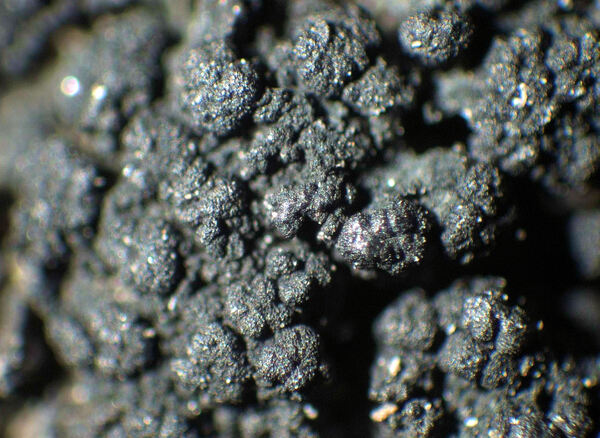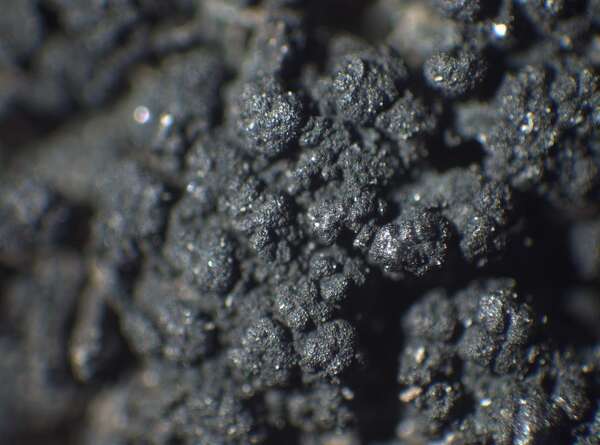Micarea turfosa (A. Massal.) Du Rietz
Svensk Bot. Tidskr., 17: 94, 1923. Basionym: Biatora turfosa A. Massal. - Ric. Auton. Lich. Crost.: 128, 1852.
Synonyms: Lecidea turfosa (A. Massal.) Jatta; Lecidea verrucula (Norman) Th. Fr.; Lecidella verrucula (Norman) Stein; Micarea verrucula (Norman) Hedl.; Oedemocarpus turfosus (A. Massal.) Trevis.
Description: Thallus crustose, episubstratic, continuous, blackish grey to brown-black, subgelatinous when wet, up to 70 μm thick, forming up to 3-5 cm wide patches, the outer hyphae with a dark green pigment reacting K-, N+ red. Apothecia micareoid, usually numerous and often confluent, 0.1-0.3(-0.4) mm across, black to rarely dark red-brown, with a convex to subglobose disc, without a distinct proper margin. Proper exciple poorly developed but usually visible in very young apothecia, reddish brown, of radiating, branched and anastomosing hyphae; epithecium and upper part of hymenium blue-green, K-, N+ red; hymenium 30-50 mm high, greenish in upper part, olivaceous-brown, fuscous brown or orange-brown in lower part; paraphyses numerous, branched and anastomosing, the walls in upper part olive-black to sordid green, surrounded by the dark olivaceous or aeruginose incrusted gel-matrix, 1.2-1.5(-2) μm thick at mid-level, the upper cells to 3.5 μm wide; hypothecium scarcely differentiated from the hymenium, mottled reddish brown, 60-140 μm high, K-, N- or N+ orange-brown. Asci 8-spored, clavate to cylindrical-clavate, with a K/I+ pale blue apical dome with a dark blue tubular structure, 35-45 x 10-12 μm. Ascospores (0-)1(-3)-septate, oblong-ellipsoid to spindle-shaped, sometimes slightly curved, (10-)12-21(-25) x (3.5-)4-5(-7) μm. Pycnidia immersed, inconspicuous, to 0.04 mm across, the wall sordid green, K-, N+ red. Microconidia cylindrical, 3.5-4.5 x c. μm. Photobiont micareoid, the cells 4-7 μm wide. Spot tests: thallus and apothecia K-, C-, KC-, P-, UV-. Chemistry. without lichen substances.
Growth form: Crustose
Substrata: soil, terricolous mosses, and plant debris
Photobiont: green algae other than Trentepohlia
Reproductive strategy: mainly sexual
Commonnes-rarity: (info)
Alpine belt: very rare
Subalpine belt: rare
Montane belt: extremely rare
Dry submediterranean belt: absent
Humid submediterranean belt: absent
Padanian area: absent
pH of the substrata:
1 2 3 4 5
Solar irradiation:
1 2 3 4 5
Aridity:
1 2 3 4 5
Eutrophication:
1 2 3 4 5
Poleotolerance:
0 1 2 3
Altitudinal distribution:
1 2 3 4 5 6
Rarity
absent
extremely rare
very rare
rare
rather rare
rather common
common
very common
extremely common
Loading data...
Occurrence data
Predictive map
Growth form: Crustose
Substrata: soil, terricolous mosses, and plant debris
Photobiont: green algae other than Trentepohlia
Reproductive strategy: mainly sexual
Commonnes-rarity: (info)
Alpine belt: very rare
Subalpine belt: rare
Montane belt: extremely rare
Dry submediterranean belt: absent
Humid submediterranean belt: absent
Padanian area: absent
pH of the substrata:
| 1 | 2 | 3 | 4 | 5 |
Solar irradiation:
| 1 | 2 | 3 | 4 | 5 |
Aridity:
| 1 | 2 | 3 | 4 | 5 |
Eutrophication:
| 1 | 2 | 3 | 4 | 5 |
Poleotolerance:
| 0 | 1 | 2 | 3 |
Altitudinal distribution:
| 1 | 2 | 3 | 4 | 5 | 6 |
Rarity
absent
extremely rare
very rare
rare
rather rare
rather common
common
very common
extremely common
Loading data...
Occurrence data
Predictive map








